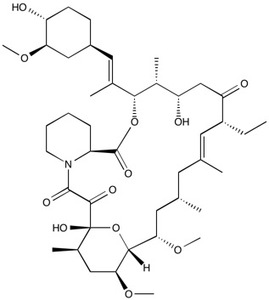Ascomycin | FKBP ligand/Immunosuppressant
NMR (Conforms)

Available Options
| size : | Price | Quantity | |
|---|---|---|---|
| 5 mg | $35.00 | ||
| 25 mg | $120.00 |
Ascomycin (11011-38-4) is an analog of FK-506 (Cat.# 10-1103). Potent immunosuppressant1. Binds to FKBP122 and inhibits calcineurin and NFAT. Ascomycin displays anti-inflammatory effects in skin diseases3. Cell permeable and active in vivo.
References/Citations:
1) Hatanaka et al. (1988), FR-900520 and FR-900523, novel immunosuppressants isolated from a Streptomyces. II. Fermentation, isolation and physio-chemical and biological characteristics; J. Antibiot. (Tokyo), 41 1592
2) Petros et al. (1991), NMR studies of an FK506 analogue [U-13C]ascomycin, bound to FKBP: conformation and regions of ascomycin involved in binding; J. Med. Chem., 34 2925
3) Mollison et al. (1999), A macrolactam inhibitor of T helper type 1 and T helper type 2 cytokine biosynthesis for topical treatment of inflammatory skin diseases; J. Invest. Dermatol., 112 729
NMR (Conforms)
Safety Data Sheet:
Product Data Sheet:
Materials provided by Focus Biomolecules are for laboratory research use only and are not intended for human or veterinary applications. Please note that we do not sell to individuals and that all orders placed by non-research organizations will incur a $20 restocking/refund fee
Ascomycin (11011-38-4) is an analog of FK-506 (Cat.# 10-1103). Potent immunosuppressant1. Binds to FKBP122 and inhibits calcineurin and NFAT. Ascomycin displays anti-inflammatory effects in skin diseases3. Cell permeable and active in vivo.
References/Citations:
1) Hatanaka et al. (1988), FR-900520 and FR-900523, novel immunosuppressants isolated from a Streptomyces. II. Fermentation, isolation and physio-chemical and biological characteristics; J. Antibiot. (Tokyo), 41 1592
2) Petros et al. (1991), NMR studies of an FK506 analogue [U-13C]ascomycin, bound to FKBP: conformation and regions of ascomycin involved in binding; J. Med. Chem., 34 2925
3) Mollison et al. (1999), A macrolactam inhibitor of T helper type 1 and T helper type 2 cytokine biosynthesis for topical treatment of inflammatory skin diseases; J. Invest. Dermatol., 112 729
Related Immunomodulators
Download
Calculate the molar concentration, mass or volume in a solution.
Concentration × Volume × Molecular Weight = Mass
Focus Biomolecules • Plymouth Meeting, PA USA • 1-855-FOCUS21
Focus Biomolecules
Plymouth Meeting, PA USA
1-855-FOCUS21
Website Created by Advanta Advertising LLC.

